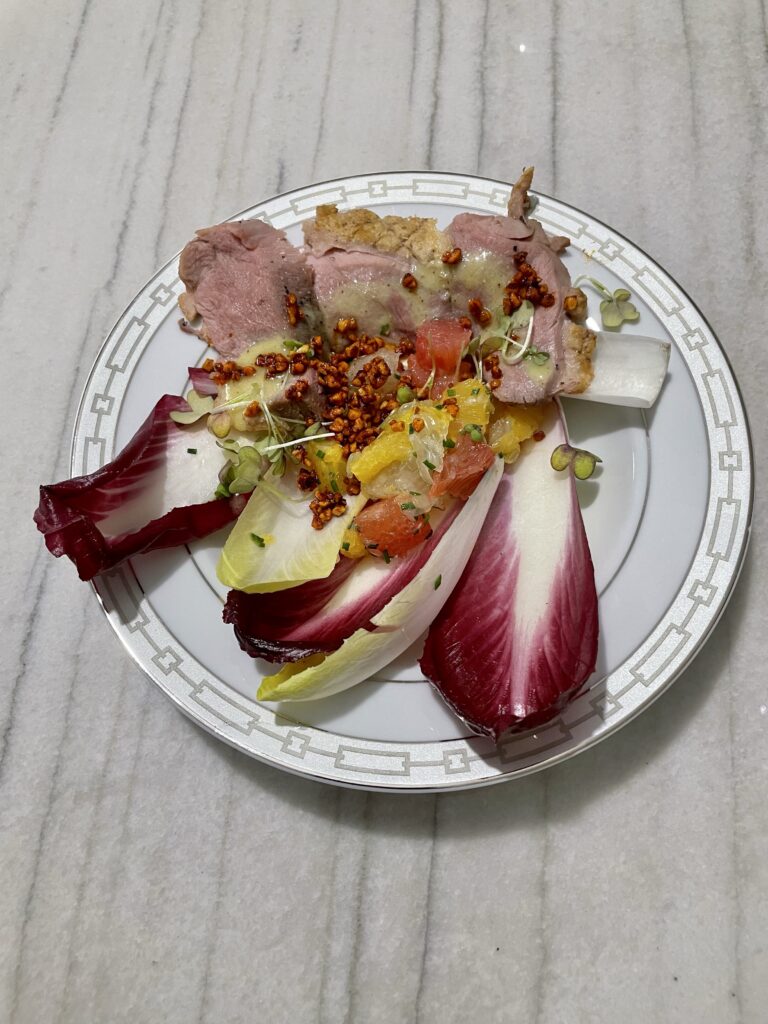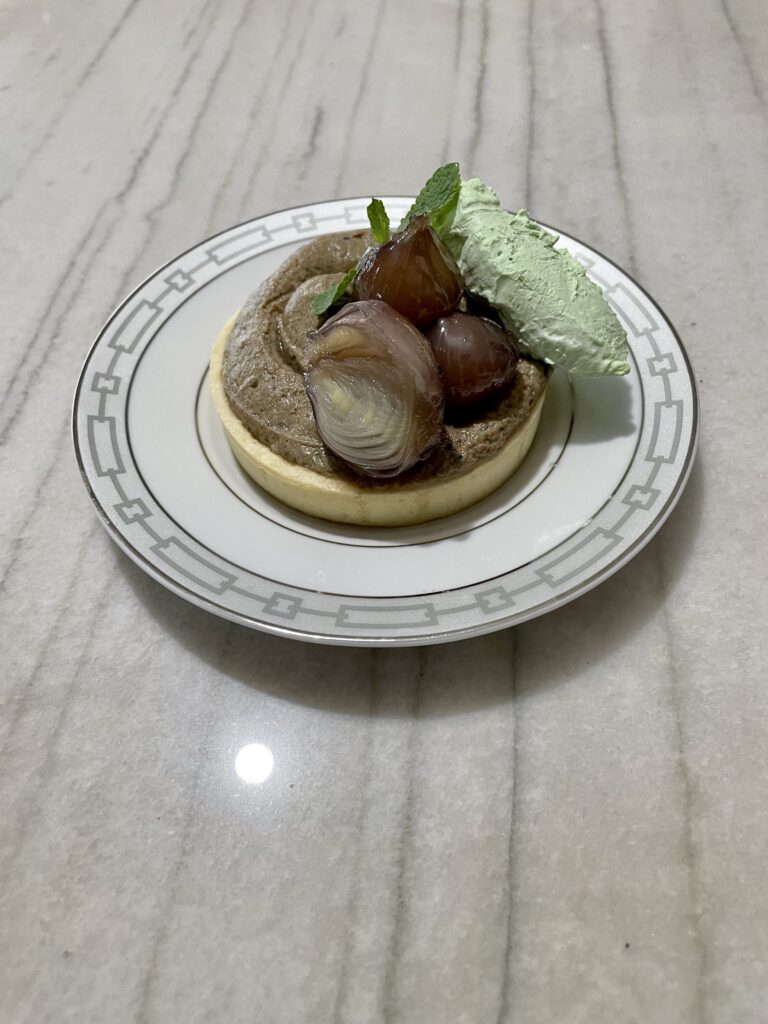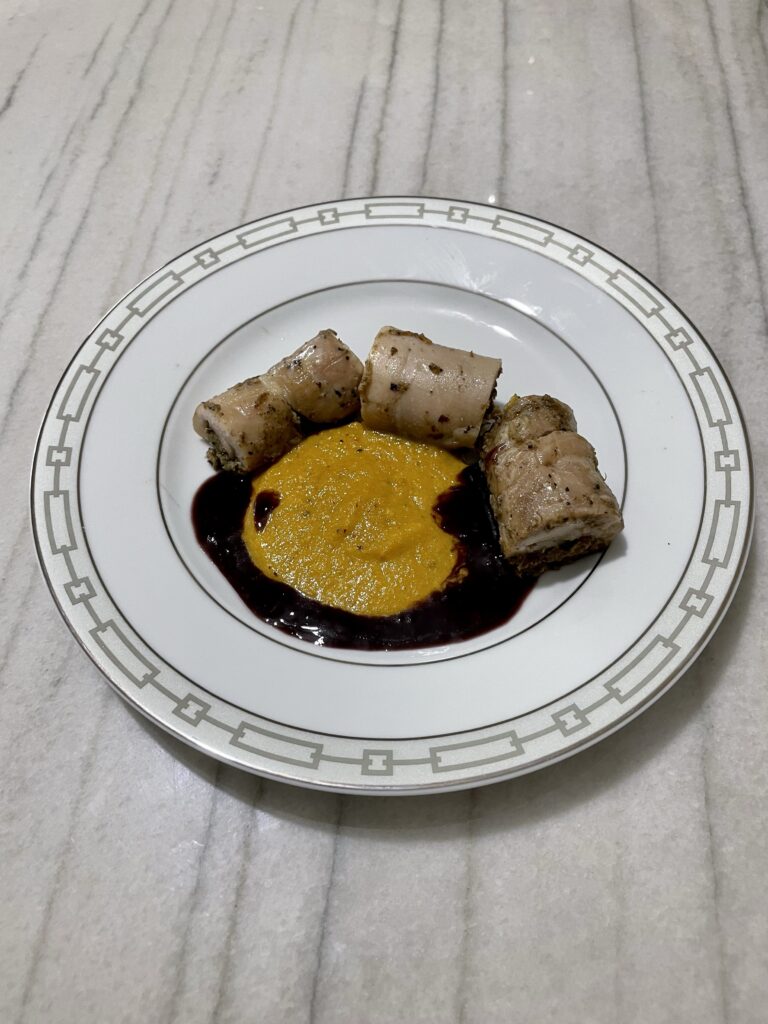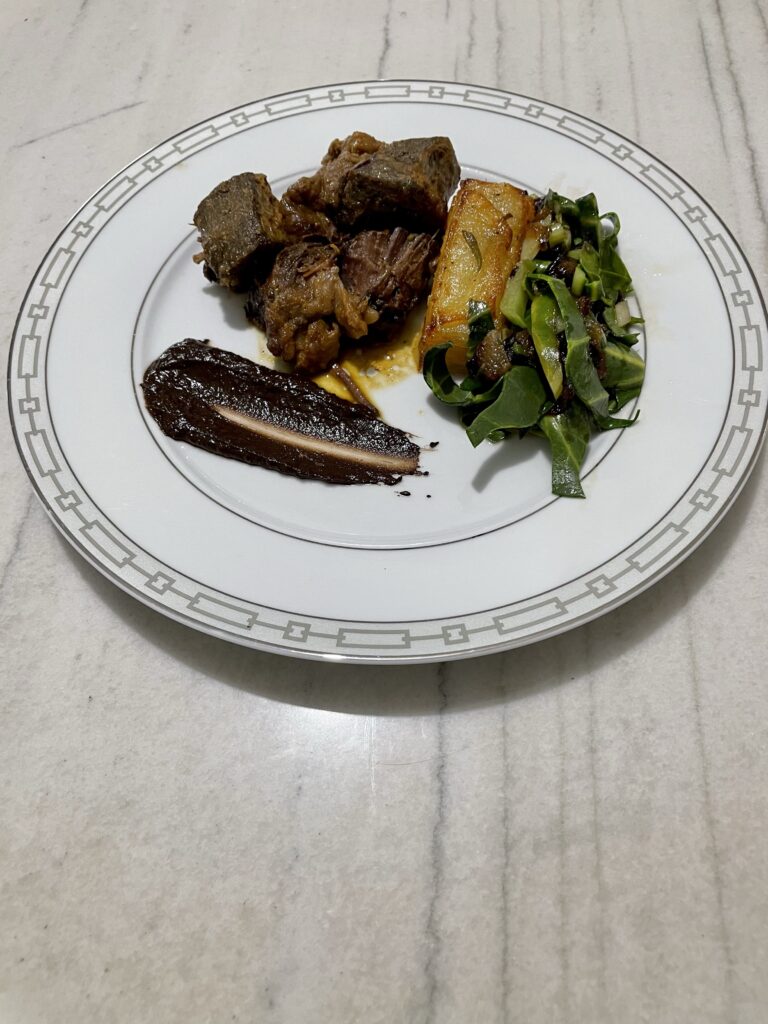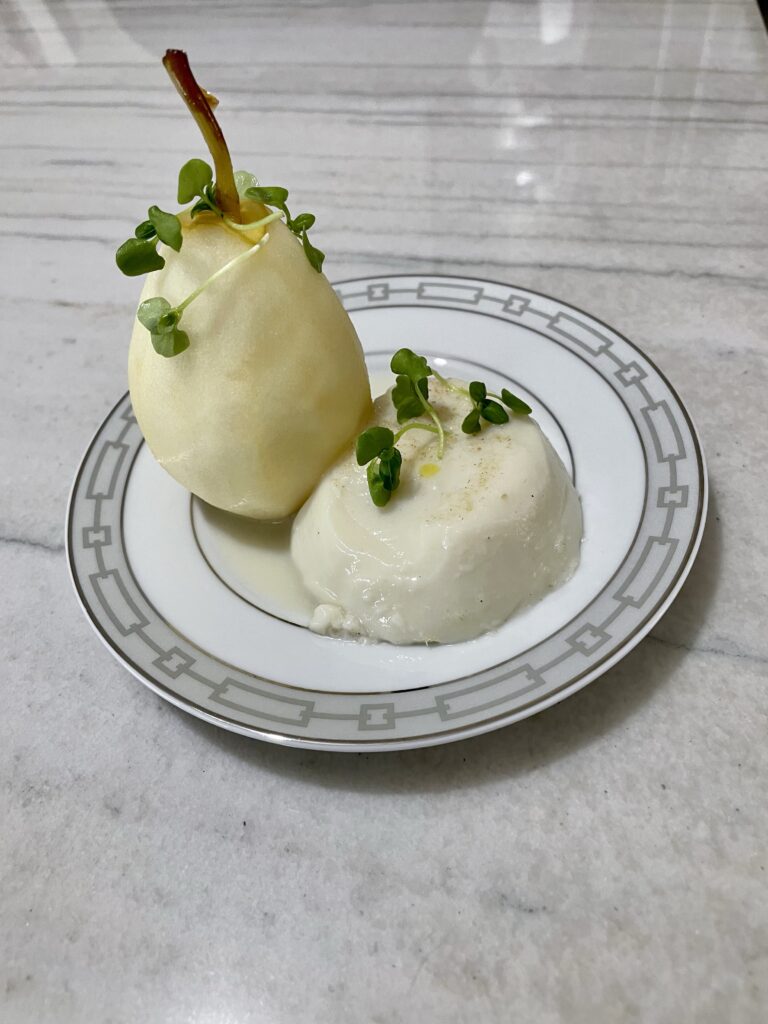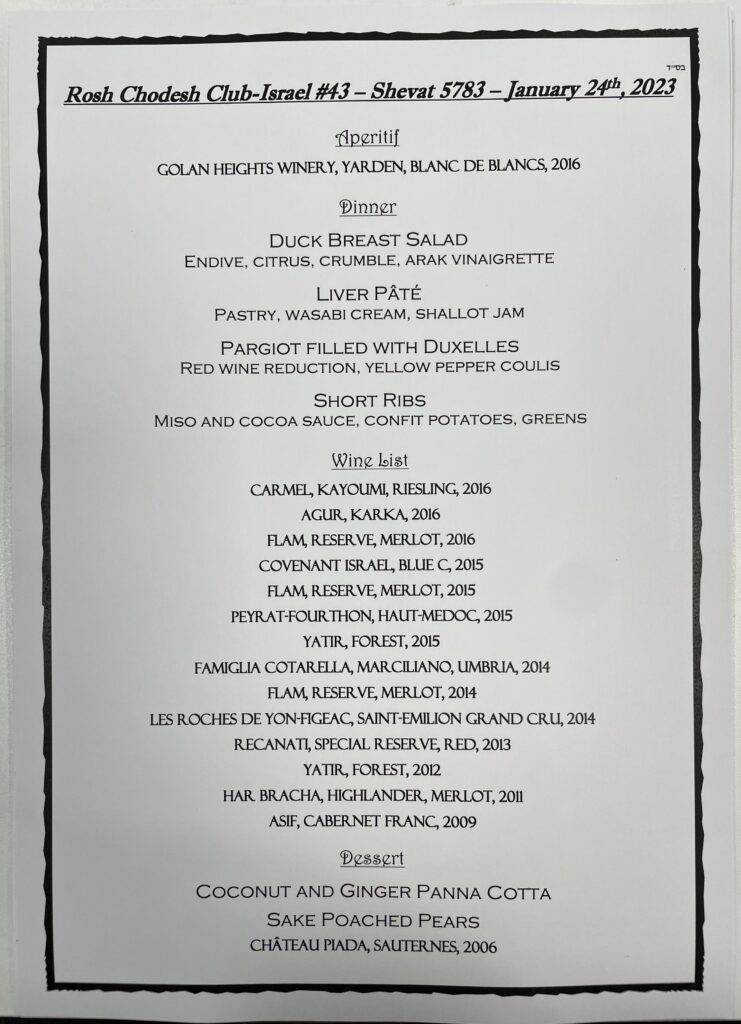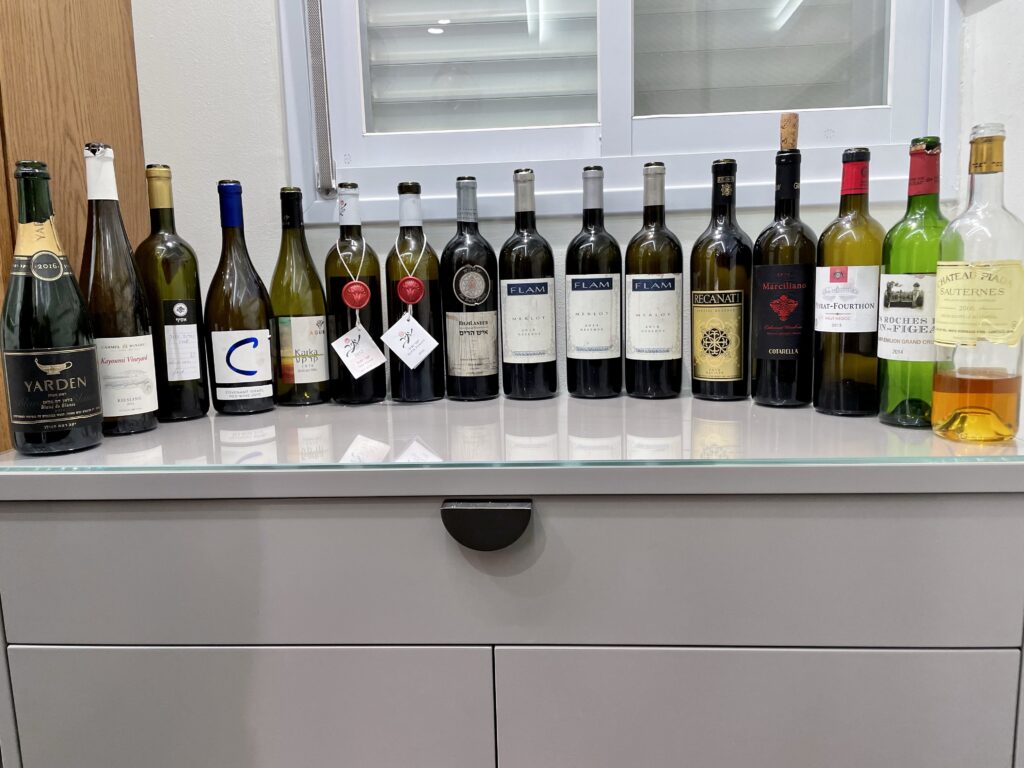I have three posts that I am working on simultaneously regarding various tastings – but before I could finish any of them a new month has begun – and that means an RCC has taken place. Again, we had the pleasure of having Chef Amrom Pitterman cook for us, and again, I hosted it in my home in Beit Shemesh rather than in Jerusalem. Each course was inventive and delicious, and Amrom also made allowances for those diners with special requests (like Keto/Low carb friendly alternatives). Everything turned out great. You’ll find pics of the various dishes below.
This month we ended up with 15 participants – which we have not had in a long time. I guess things are completely back to normal. I have to remember that 15 is simply WAY to many people – with optimum being 10-12. Any more and you can’t have a conversation with everyone at the table at once – and the pours for each bottle are smaller than is ideal. In any event, I think people still enjoyed themselves.
The wines were a mixed bag this month. We had a lot of Israeli wines with some French and Italian thrown in. Not all of the wines were hits, but such is life. What’s important is that the evening as a whole was interesting and people had fun eating, drinking and discussing.
Here are the wines we enjoyed:
2016 Golan Heights Winery, Yarden, Blanc de Blancs – 12.5% abv – I thought perhaps that the bottle I tasted in France might have tasted sub-par due to shipping, and so I was happy to have an opportunity to taste again relatively quickly. My notes have not changed at all. The wine is nice enough, but ultimately lacks the depth of previous vintages. 89.5
2016 Carmel, Kayoumi, Riesling – 11.5% abv – This wine is showing its age beautifully. It now has notes of paraffin and petrol with an unctuous body. The acid has receded a touch, so I wouldn’t hold these too long. To me, they are at peak or even slightly past. So enjoy them NOW before they really drop off! 91
2008 Asif, Cabernet Franc – (The menu reads 2009, but that was mistake.) This wine was made by Yaacov Oryah at his first winery, Asif, as a test run and was not commercially sold. The wine is still alive – even though it was not built to be a “big wine” for aging. So that in itself is an achievement. The wine is varietally true for most part, and the acid and tannin are both still very much felt in the wine. There is balance and even finesse. The only thing lacking here is depth, which you would want in an RCC level bottle – but this bottle wasn’t built for that. Again – I was happy that we got to taste this little wine and was even happier with how it held up. 88
2015 Covenant Israel, Blue C – 15.4% abv – This wine was completely flat and lifeless. Don’t know if this is bottle specific or that this speaks to the entire run, as I haven’t had one of these in years. 80
2016 Agur, Karka – 14% abv – This is now the second time I have had an Agur Karka – which is made from Oseleta grapes. The last time was the 2014 vintage. You can read about the grape, wine, and the backstory here. This wine was only made in 2014, 2015, and 2016. After that, the vines were uprooted so this is really a piece of history. The 2016 is very close to the 2014 with one notable difference: Brett. This wine has a significant amount. I happen to think that in most cases Brett enhances the profile, and that was the case here, where, for me, it absolutely highlighted the wines already earthy notes. There were those who felt that the Brett was simply way too much and dominated the wine. In any event, this was one of the more interesting wines of the night and, for me, was wholly enjoyable. 90
2012 Yatir, Forest – 14.5% abv – We tasted two of the Yatir Forest back-to-back. The 2012 was the more elegant of the two in terms of profile, ripe red fruit and berries, nice warm spice, and some leather on the finish. The problem really is with the acid which has flattened out. This wine is just simply past peak. Drink up if you have any. 87
2015 Yatir, Forest – 15% abv – As I mentioned, we drank this back-to-back with the 2012. This wine had the opposite problem of its younger brother – The wine is not past peak at all. The acid and tannin are still showing where they should be for this wine. The problem is with the wine itself – likely a victim of the 2015 vintage. It’s just WAY too ripe for me and presents unbalanced. Which one was better – I mean, does it make a difference? For me they both get the same sub-par score. 87
2011 Har Bracha, Highlander, Merlot – 15% abv – This wine is a testament to the quality Merlot available at Har Bracha. The wine is alive and well 12 years after harvest. The problem here is this is a style of wine I NEVER like, with crazy oak contributing notes of sweet vanilla and WAY overripe fruit, giving you all sorts of dried fruit notes like fig, date, and prune. But the wine was professionally made and built to last. The tannin Is nicely integrated but firm and the acid, what there is of it, is still vibrant. But ultimately it’s just not for me. 87
2014 Flam, Reserve, Merlot – 13.8% abv – We next tasted two (well three, but one was corked) Flam Merlots. This wine again presents more elegantly than its slightly younger brother. I have to say at first I was unimpressed. The wine was nice but was subdued somehow (a problem that the 2015 does not have) and so, even though it had the nicer profile, I was a little down on the wine. Ultimately though, with some air, the wine woke up and displayed some nice flavors, nice plum and raspberry and good herbs. The tannin is nice – and with time the acid comes out. The finish is medium length with more herb and some tobacco. Nice bottle overall. 90.5
2015 Flam, Reserve, Merlot – 14% abv – This wine was good to go right out of the bottle – but, again, has many of the same problems that plague the 2015 vintage. It’s VERY ripe and a bit unbalanced – but it’s not bad – and actually better than the Yatir we had. But the red fruit is close to candied with plum and dark red cherry. The acid is clear and present, but you would need a ton more to balance out the fruit here. The finish is oak and sweet tobacco. 88
2016 Flam, Reserve, Merlot – 14% abv – Corked.
2013 Recanati, Special Reserve, Red – 14% abv – Same notes as I had on the Covenant – flat as a board and lifeless. The fruit might have been a touch more defined – but, really, the wine was near dead. Surprising for this wine. Could just be a bad bottle – but I wouldn’t chance it. 83
2014 Famiglia Cotarella, Marciliano, Umbria – 15% abv – This wine has not moved even an inch since my last tasting almost three years ago. In fact, it might be more closed now. It was decanted for 2.5 hours and run through a vinturi, and only then did it start to show. This is a monster wine. Give it the time and respect it deserves – and wait at least another year (maybe 2-3) before trying again. 92
2014 Les Roches de Yon-Figeac, Saint-Emilion Grand Cru – 12.5% abv – This wine was another one that didn’t start well for me – but with air really came together. For the first 15 minutes or so there was a weird metallic thing going on with his wine that really bothered me. But that blows off and you get some very nice red fruit – primarily raspberry, plum, and cherry with nice graphite. The finish is long, and here is where you get the nice tertiary notes of leather and some tobacco, and there is a little cedar thrown into the mix as well. Really nice bottle. 91.5
2015 Peyrat-Fourthon, Haut-Medoc – 13.5% abv – Another wine that thankfully has not changed at all since my last tasting in France. For me this was THE wine of the night. And a QPR SUPERSTAR – it goes for about 30 Euro or so from what I remember. Just incredible. 93
2006 Château Piada, Sauternes – 14.5% abv – Typical Sauternes flavors – primarily apricot and honey. The problem is the wine is likely a bit over the hill, as the acid has faded and really – you feel it. Still it was enjoyable enough and went really well with the desserts. 88
Well that wraps it up for this month. Back to the regularly scheduled wine writing…. Chodesh Tov!
